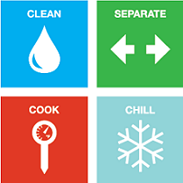Is Garden Safe Brand Diatomaceous Earth Food Grade
Four Easy New Year's Resolutions to Be Food Safe
Image

At the New Year many of us think about changes to make our lives happier and healthier and resolve to carry them out. Sometimes the changes are big and difficult, like losing 40 pounds or training for a marathon, and they turn out to be so difficult in the press of work, family responsibilities, etc., that we forget them. But resolving to take the small, simple steps to be food safe in the New Year is neither big nor difficult and can have a major pay-off.
Maybe you don't take food poisoning, also called foodborne illness, very seriously but the Federal government estimates that there are about 48 million cases of foodborne illness annually – the equivalent of sickening 1 in 6 Americans each year. And each year these illnesses result in an estimated 128,000 hospitalizations and 3,000 deaths. And while foodborne illness can be severe, even life-threatening, for anyone, it's especially dangerous for those most at risk — older adults, infants and young children, pregnant women, and people with HIV/AIDS, cancer, diabetes, or any condition that weakens their immune systems.
Threats to food safety constantly evolve. New disease-causing organisms emerge and known pathogens become stronger. In addition, consumers increasingly want food that is less processed. Despite all that government and the food industry do to help make food safe, it's clear that individuals need to take every practical step they can to prevent foodborne illness.
So, here are a few suggestions for resolutions to help:

Clean: Resolve to wash your hands before, during and after handling food. According to the Centers for Disease Control and Prevention, handwashing has the potential to save more lives than any single vaccine or medical intervention. To do it effectively, wet your hands with clean running water (warm or cold) and apply soap. Rub your hands together to make lather and scrub them well for at least 20 seconds. Air dry or use a clean paper towel.
Separate: If you only have one cutting board, resolve to get another to help avoid pathogens from one food migrating to another, called cross-contamination. Use one for foods that will be cooked, such as meat, poultry, and seafood, and the other for foods like fruits and vegetables that will be eaten raw. That way the raw foods won't be contaminated by the juices from the ones to be cooked. If you do get a new cutting board, get one that's dishwasher-safe. The very hot water and strong detergent typically used in dishwashers can eliminate a lot of bacteria.
Cook: Only by using a food thermometer can you be sure that meat, poultry, fish and casseroles are cooked to a safe internal temperature—hot enough to kill any pathogens that may be present: 145°F for whole meats (allowing the meat to rest for 3 minutes before carving or consuming), 160°F for ground meats,165°F for all poultry, and 165°F for casseroles and leftovers.
Chill: Similarly, resolve to get an appliance thermometer to be sure your refrigerator is at or below 40ºF. Between 40ºF and 140ºF is the Danger Zone where bacteria multiply rapidly. The more bacteria, the more likely someone will get sick. Most refrigerators have just a colder/warmer adjustment, so the only way to know the temperature is to put a thermometer inside. And it's a good idea to put one in the freezer to be sure the temperature is 0ºF or below.
For more information, check out these resources:
- Types of Food Thermometers
- Separate, Don't Cross-Contaminate
- Making Food Safer to Eat
Is Garden Safe Brand Diatomaceous Earth Food Grade
Source: https://www.fda.gov/food/buy-store-serve-safe-food/four-easy-new-years-resolutions-be-food-safe
Posted by: alexanderhopil2000.blogspot.com

0 Response to "Is Garden Safe Brand Diatomaceous Earth Food Grade"
Post a Comment